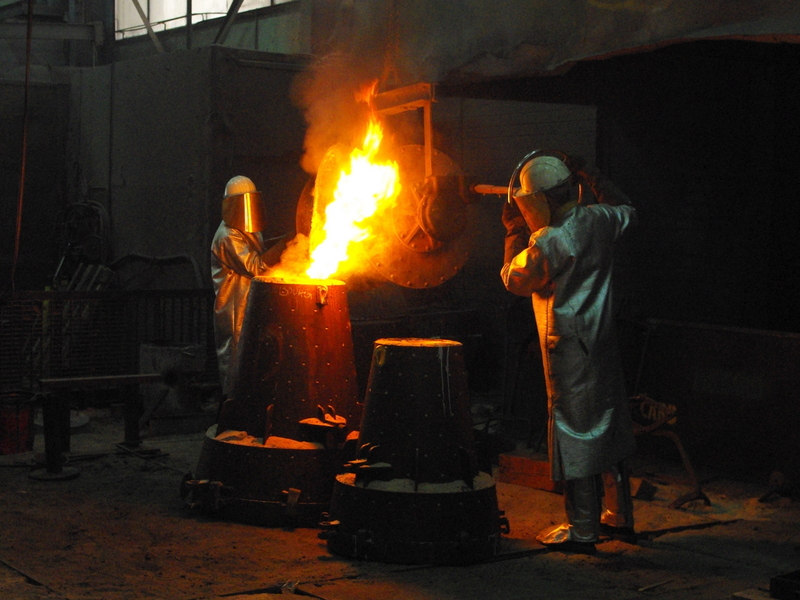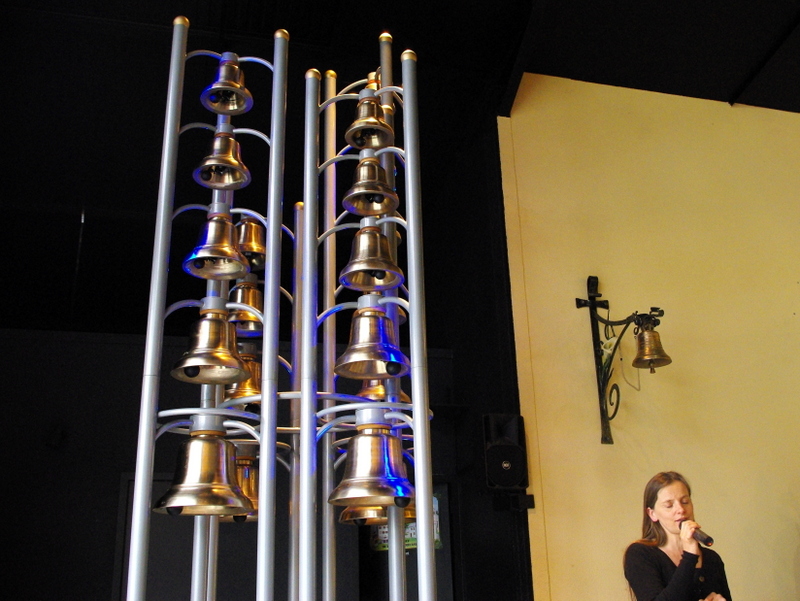A visit to the museum of the Paccard bell foundry is one of the most interesting attractions when discovering Annecy and its beautiful region. With its extraordinary history, the family business has become, over the last two centuries, a flagship of French savoir-faire to the world. Their bells are found in every continent, from Europe to America and Australia. Nicknamed the “Bell Stradivarius” (le Stradivarius de la cloche) for the high quality of its bells, the foundry is now located in Sévrier in the suburbs of Annecy, by the turquoise waters of its lake.
The Paccard Bell Foundry story

Once upon a time there lived a young man by the name of Antoine in Quintal, a little village beautifully situated at the foot of the Alps. Times were hard for the villagers of the independent Duchy of Savoy: the neighbouring country – France – was living through a period of political turmoil known as the French Revolution. The ideals of the Revolutionaries spread well outside France and took root in Savoy. In an effort to erase all religious signs and symbols from the land, church bells were taken down to be cast into cannons and priests were sacked, if not persecuted.
However the bells meant more than ringing the hour for Mass. As watches did not exist, the bells were important in marking the hours of the day, hence structuring the local life of a village.
Without any priest or bells, the village of Quintal was left helpless without the possibility of organising significant life-events such as weddings, christenings and funerals.
As the new mayor of the village, Antoine Paccard resolved to ask the local bishop for help. As times were hard – if not dangerous for a priest-, the bishop was quite reluctant to grant him this favour. Upon the insistence of the mayor, his excellency agreed but to one condition: “You will have a priest when there will be a bell in the church tower”.
Antoine came back home and asked Jean-Baptiste Pitton, a master bell-caster from Carouge near Geneva, to cast a bell for the village’s church. Pitton agreed but needed an assistant to help him in the task. The 24 year old man naturally proposed himself and the bell was cast in 1796. It still rings today from the little tower of the church in Quintal.

Thanks to the experience he had gained in bell-casting, Antoine founded the Paccard Bell Foundry in Quintal, which was moved to Annecy-le-Vieux in 1857 and more recently (in 1989) to a new site in Sévrier.
By the end of the 19th century, the renown of the Paccard bells was expanding worldwide due to the beauty of their shape, the accuracy of their tonality and the fullness of their tone and harmony. The director of that time, Georges Paccard, oversaw the casting of 10,000 bells including the famous “La Savoyarde”, France’s biggest bell (18,835 kg), cast in 1891 for the Sacré-Cœur basilica in Montmartre, Paris.
Other famous bells cast by Paccard are the “Jeanne d’Arc” in Rouen and the American “Liberty Bell”. In addition, the Paccard foundry became the world specialist in carillon bells which originally came from Belgium and Holland.
In 1950, the United States commissioned from Paccard 54 copies of the famous “Liberty Bell” intended to be offered to the capitals of each State. More recently, in 1998, the bell foundry cast, in Nantes, the World Peace Bell, the largest swinging bell in the world. The enormous bell which is found Newport, Kentucky, US weighs 33,285 kg (75,837 pounds).
The Paccard bells: a success story

Today, the bell foundry has become a flagship of French savoir-faire in Annecy and 70% of its production is destined for export, mainly to the USA, Canada and Japan. Since the foundation of the bell foundry, more than 120,000 bells have been cast by Paccard. Their bells can be heard ringing in many places around the globe: in Paris, Rouen, Dubai, Lourdes, New York, Dallas, Washington, Montreal, Tokyo, the Seychelles…
In Australia, five bells manufactured by Paccard were installed on the 30th September 2001 at Sacred Heart Cathedral, Bendigo and six new bells were set up in Adelaide for a North Queensland church in 2013.

The Paccard foundry produces bell accessories (strikers, frames, bell towers, mountings…) as well as an innovative concept based on new technologies called Ars Sonora®. Placed in town squares or corporate complexes, the monumental “musical sculptures” are not just appealing to the eye but are real musical instruments. Each Ars Sonora® represents a unique work of art made up of the beautifully resonant sound of the Paccard bells. The new concept combines the art of bell-making with fine sculpture and design.
The Paccard Museum

The museum was founded in 1984 to present the craftsmanship and savoir-faire of the Paccard bell foundry. It presents to its visitor the extraordinary story of the family business from the first cast of the Quintal bell in 1796 to the recent Ars Sonora® concept.
The guided tour of the museum is led by a passionate team which shares the art of bell making. The exhibition rooms display a collection of tools, documents, engravings, pictures and bells which provide visitors with useful information about the craft of making fine cast bronze bells. An interesting 20 minute video shows the making of the largest swinging bell in the world, the World Peace Bell.

There are many options offered to visitors (some depending on the workshop schedule): guided tours of the museum, customised group tours, vocal and carillon concerts, guided tours of the workshops and bell-casting demonstrations.
More information about visiting the museum can be found here.
Famous Achievements

More than 120,000 bells have been cast by Paccard since the beginning of its activity in the late 18th century. Their bells can be heard ringing in many places around the globe: in Paris, Rouen, Washington, Melbourne, Montreal, Tokyo, the Seychelles…
- 1891: La Savoyarde, France’s largest bell (18,835 kg). Sacré-Cœur, Montmartre, Paris.
- 1914: La Jeanne d’Arc. The original great bell (16 tonnes) was cast in 1914 but was destroyed in June 1944. A new and smaller bell of the same name was replaced in 1959 (10 tonnes). Rouen Cathedral.
- 1950: Liberty Bell, a replica in 54 copies of the bell that sounded the independence of the United States of America on 4th July 1776 in Philadelphia.
- 1986: The world’s largest three-bell carillon, weighing 14,500 kg (32,000 pounds), and 300 cm diameter. Cathedral of the Transfiguration, Markham, Canada.
- 1937-1993: France’s largest carillon (70 bells). Castle of the Dukes of Savoy, Chambéry.
- 1998: La Cloche de la Paix (World Peace Bell), the world’s largest bell (33,285 kg), Newport, Kentucky, US.
- 2000: Mont Valérien Bell, a giant memorial bell on which the names of 1008 executed men during the Second World War have been engraved. Mont Valérien, Suresnes, Île de France.
The Paccard Bell Foundry: English-French Vocabulary
(f) for féminin, (m) for masculin, (adj) for adjective and (v) for verbs
- achievement = réalisation (f)
- bell = cloche (f)
- bell tower = clocher (m)
- bishop = évêque (m)
- carillon = carillon (m)
- to cast = fondre (v)
- church = église (f)
- exportation = exportation (f)
- foundry = fonderie (f)
- great bell = bourdon (m)
- to manufacture = fabriquer (v)
- mayor = maire (m)
- museum = musée (f)
- musical sculptures = sculptures musicales (f)
- priest = prêtre (m)
- to produce = produire (v)
- Savoy = Savoie (f)
- shape = forme (f)
- sound = son (m)
- village = village (m)
- to visit = visiter (v)
- visitor = visiteur (m)
- workshop = atelier (m)
Visit the Museum of the Paccard Bell Foundry website here.
Have you visited the Paccard Bell Foundry museum too? We’d be interested in hearing about your feedback!



